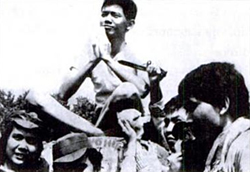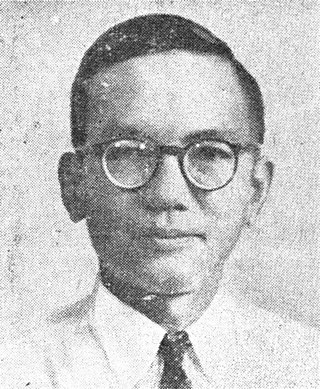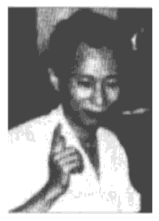
The Peranakan Chinese are an ethnic group defined by their genealogical descent from the first waves of Southern Chinese settlers to maritime Southeast Asia, known as Nanyang, namely the British Colonial ruled ports in the Malay Peninsula and the Indonesian Archipelago, as well as Singapore. Peranakan culture, especially in the dominant Peranakan centres of Malacca, Singapore, Penang, Phuket and Tangerang, is characterized by its unique hybridization of ancient Chinese culture with the local cultures of the Nusantara region, the result of a centuries-long history of transculturation and interracial marriage.

Soe Hok Gie was a Chinese Indonesian activist who opposed the successive dictatorships of Presidents Sukarno and Suharto.
Ong Hok Ham was an eminent Chinese Indonesian historian considered one of the leading experts on Indonesian history during the 19th century Dutch colonial rule. His particular area of knowledge centered on events in Java during the period, and he authored a number of works dealing with the subject.

Petrus Kanisius Ojong, better known as P. K. Ojong, was an Indonesian journalist and businessman who was one of the founders of Kompas Gramedia Group, Indonesia's largest conglomerates and Kompas, one of Indonesia's most circulated daily newspapers, together with Jakob Oetama.

Lie Kim Hok was a peranakan Chinese teacher, writer, and social worker active in the Dutch East Indies and styled the "father of Chinese Malay literature". Born in Buitenzorg, West Java, Lie received his formal education in missionary schools and by the 1870s was fluent in Sundanese, vernacular Malay, and Dutch, though he was unable to understand Chinese. In the mid-1870s he married and began working as the editor of two periodicals published by his teacher and mentor D. J. van der Linden. Lie left the position in 1880. His wife died the following year. Lie published his first books, including the critically acclaimed syair (poem) Sair Tjerita Siti Akbari and grammar book Malajoe Batawi, in 1884. When van der Linden died the following year, Lie purchased the printing press and opened his own company.

Tio Ie Soei was a peranakan Chinese writer and journalist active in the Dutch East Indies and Indonesia. Born in the capital at Batavia, Tio entered journalism while still a teenager. By 1911 he had begun writing fiction, publishing Sie Po Giok – his first novel – that year. Over the next 50 years Tio wrote extensively in several newspapers and magazines, serving as an editor for some. He also wrote several novels and biographies, including ones on Tan Sie Tat and Lie Kim Hok.

Kan Hok Hoei Sia, generally known as Hok Hoei Kan or in short H. H. Kan, was a prominent public figure, statesman and patrician landowner of Peranakan Chinese descent in the Dutch East Indies.

Lauw Giok Lan was a Chinese Indonesian journalist and writer. He was one of the founders of the newspaper Sin Po.
Phoa Liong Gie Sia was an Indonesian-born Swiss jurist, politician and newspaper owner of the late colonial era in the Dutch East Indies.

The Cabang Atas —literally 'upper branch' in Indonesian—was the traditional Chinese establishment or gentry of colonial Indonesia. They were the families and descendants of the Chinese officers, high-ranking colonial civil bureaucrats with the ranks of Majoor, Kapitein and Luitenant der Chinezen. They were referred to as the baba bangsawan [‘Chinese gentry’] in Indonesian, and the ba-poco in Java Hokkien.

Kwee Hing Tjiat was a Chinese-Malay journalist and a leading peranakan Chinese intellectual of the late colonial era.

Sin Po was a Peranakan Chinese Malay-language newspaper published in the Dutch East Indies and later Indonesia. It expressed the viewpoint of Chinese nationalism and defended the interests of Chinese Indonesians and was for several decades one of the most widely read Malay newspapers in the Indies. It existed under various names until 1965.

Mr. Tjung Tin Jan or Jani Arsadjaja was an Indonesian politician and lawyer of Chinese Indonesian origin.
Keng Po was a Malay language Peranakan Chinese newspaper published in Batavia, Dutch East Indies from 1923 to 1958. During most of that time it was the second-most popular Malay-language Chinese newspaper in the Indies after Sin Po. It was also an important paper in the early period of Indonesian independence in the 1950s.

Njonja Tjoa Hin Hoei, who was born Kwee Yat Nio and was also known by the Buddhist name Visakha Gunadharma, was a Chinese Indonesian journalist, writer, Buddhist figure, and political activist during the late colonial and early independence periods. She was especially known for being publisher and editor of a women's magazine Maandblad Istri which ran from the 1930s to the early 1950s.

Injo Beng Goat was a Chinese Indonesian journalist, lawyer, and political activist of the late Dutch East Indies and early independence era in Indonesia. He was editor-in-chief of Keng Po, one of the largest newspapers of the early independence period, until 1958.

Tjerita Roman was a monthly Peranakan Chinese, Malay-language literary magazine published in the Dutch East Indies from 1929 to 1942. It was one of the most successful literary publications in the Indies, publishing hundreds of novels, plays, and short stories during its run. Among its authors were many of the notables of the Chinese Indonesian literary world including Njoo Cheong Seng, Pouw Kioe An, Tan Boen Soan, and Liem Khing Hoo.

Oey Kim Tiang was an Indonesian translator of Chinese novels. Born to a supervisor at a coconut plantation, Oey studied at a school run by the Tiong Hoa Hwe Koan in Tangerang. Graduating at the age of twenty, he found work with the newspaper Keng Po as a translator. His first published translation, Tong Tjioe Liat Kok, retold the Chronicles of the Eastern Zhou Kingdoms in vernacular Malay. Over the next sixty years, Oey translated dozens of works, ranging from classics of Chinese literature such as Journey to the West to the wuxia novels of Jin Yong and Liang Yusheng.
















